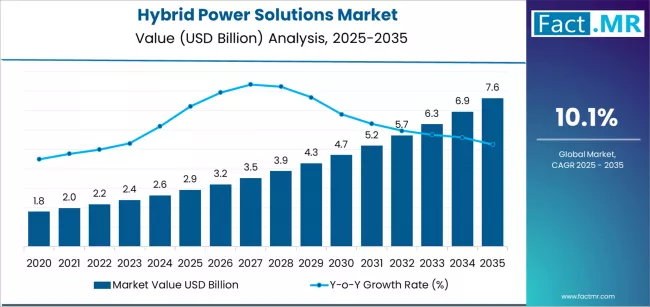MENA Renewable Energy Market to Reach $59.9 Billion by 2030, Driving a Regional Green Energy Boom | ‘BCC Research LLC’ – Yahoo Finance

Report on the Middle East and North Africa (MENA) Renewable Energy Market: A Catalyst for Sustainable Development Goals
Market Projections and Contribution to SDG 7
A recent market analysis indicates a significant expansion in the renewable energy sector within the Middle East and North Africa (MENA) region. The market is projected to reach a valuation of $59.9 billion by 2030, growing at a compound annual growth rate (CAGR) of 14.4% from 2025 to 2030. This growth trajectory underscores the region’s commitment to advancing SDG 7 (Affordable and Clean Energy) by transitioning from fossil fuel dependency towards sustainable energy systems.
The analysis focuses on key emerging economies, including Saudi Arabia, the UAE, Egypt, and Morocco, and covers various renewable sources such as solar, wind, hydro, and bioenergy. The application of these energy sources is examined across residential, commercial, and utility sectors.
Key Drivers Aligned with Global Sustainable Development
The accelerated growth in the MENA renewable energy market is propelled by several factors that align directly with the United Nations’ Sustainable Development Goals.
- National Strategies and Energy Diversification: Governments across the MENA region are implementing national strategies, such as Saudi Vision 2030 and UAE Net Zero 2050, to diversify their energy mix. These initiatives directly support SDG 7 and SDG 13 (Climate Action) by establishing policy reforms and investment incentives for clean energy.
- Abundant Natural Resources: The region’s vast solar and wind resources provide a cost-effective foundation for renewable energy projects. Harnessing these resources is a primary strategy for achieving SDG 7 on a large scale.
- Growing Energy Demand and Electrification: Increasing population and industrialization, coupled with the electrification of sectors like transport and water desalination, necessitate a sustainable power supply. This drives the demand for renewables, contributing to SDG 9 (Industry, Innovation, and Infrastructure) and SDG 11 (Sustainable Cities and Communities).
- Green Hydrogen for Economic Growth and Export: MENA nations are investing heavily in green hydrogen production for both domestic use and export. This strategy fosters economic diversification in line with SDG 8 (Decent Work and Economic Growth) and positions the region as a key player in the global transition to clean energy, supporting SDG 7.
- Industrial Decarbonization: The transition of heavy industries to renewable energy sources, including green hydrogen, is critical for reducing emissions. This directly addresses the objectives of SDG 9 and SDG 13 by promoting cleaner manufacturing processes.
- Utility-Scale Project Development: The expansion of large-scale solar and wind projects, often funded through public-private partnerships, is crucial for building resilient infrastructure and increasing clean energy capacity, reflecting the principles of SDG 9 and SDG 17 (Partnerships for the Goals).
Regional Leadership and SDG Implementation
Egypt: A Leader in Renewable Energy Transition
Egypt is projected to dominate the regional market, with its market share expected to reach $19.8 billion by 2030. The country’s commitment is demonstrated through its Vision 2030 strategy, which aims to ensure energy security and reduce greenhouse gas emissions. Key projects contributing to this leadership include:
- The Benban Solar Park: As one of the world’s largest solar installations, this 1.8 GW project is a testament to Egypt’s successful implementation of SDG 7. Its development through a Feed-in Tariff (FiT) program has attracted significant international investment, showcasing a successful model for SDG 17.
United Arab Emirates: Innovation in Solar Technology
The UAE is another key player, with ambitious projects that advance global climate goals. The Mohammed bin Rashid Al Maktoum Solar Park in Dubai is the world’s largest single-site concentrated solar power (CSP) plant. This project is a cornerstone of the UAE’s Net Zero 2050 strategy, directly contributing to SDG 7 and SDG 13.
Market Segmentation Analysis
The report segments the MENA renewable energy market to provide a detailed analysis for policymakers and investors focused on sustainable development.
- By Source: The market is analyzed by sources including solar, wind, hydropower, and bioenergy. The dominance of solar and wind power highlights the region’s strategic use of its natural advantages to meet SDG 7.
- By End-User: Segmentation includes residential, commercial, and industrial sectors. The focus on industrial decarbonization and providing clean energy to communities supports SDG 9 and SDG 11.
- By Country: The analysis covers Egypt, Morocco, UAE, Jordan, Tunisia, Saudi Arabia, Oman, Algeria, and Kuwait, offering insights into national progress towards their respective renewable energy and climate targets.
Analysis of Sustainable Development Goals in the Article
1. Which SDGs are addressed or connected to the issues highlighted in the article?
The article on the MENA region’s renewable energy market growth addresses several interconnected Sustainable Development Goals (SDGs). The primary focus is on energy and climate, but it also touches upon economic growth, industrial innovation, and partnerships. The following SDGs are relevant:
- SDG 7: Affordable and Clean Energy: This is the most central SDG, as the entire article discusses the shift to renewable energy sources like solar, wind, and green hydrogen to ensure access to affordable, reliable, and modern energy.
- SDG 13: Climate Action: The article explicitly states that MENA countries are accelerating their shift to renewables to “meet climate goals” and “reduce greenhouse gas emissions,” which directly aligns with taking urgent action to combat climate change.
- SDG 9: Industry, Innovation, and Infrastructure: The development of “utility-scale renewable energy projects,” “renewable-powered manufacturing,” and investments in “green hydrogen” infrastructure are key themes, reflecting the goal of building resilient infrastructure and fostering sustainable industrialization.
- SDG 8: Decent Work and Economic Growth: The article highlights how the renewable energy boom creates “new economic opportunities in energy trade” and drives market growth (projected to reach $59.9 billion), contributing to economic diversification and sustainable economic growth.
- SDG 17: Partnerships for the Goals: The success of the renewable energy transition is attributed to “Government-led Strategies,” “partnerships to support clean energy development,” “foreign investment,” and “public-private partnerships,” such as the one for Egypt’s Benban Solar Park.
2. What specific targets under those SDGs can be identified based on the article’s content?
Based on the article’s discussion of national strategies, investments, and technological shifts in the MENA region, the following specific SDG targets can be identified:
- Target 7.2: By 2030, increase substantially the share of renewable energy in the global energy mix.
- Explanation: The article’s core subject is the rapid expansion of the renewable energy market in the MENA region, driven by solar, wind, and green hydrogen projects. It highlights the development of large-scale projects and a projected market growth to $59.9 billion by 2030, directly contributing to increasing the share of renewables.
- Target 7.a: By 2030, enhance international cooperation to facilitate access to clean energy research and technology… and promote investment in energy infrastructure and clean energy technology.
- Explanation: The article mentions that “growing foreign investment is fueling large-scale renewable developments” and cites the Benban Solar Park in Egypt as a project that “attracted substantial international financing and participation from major global energy players.” This points directly to the promotion of investment and international cooperation.
- Target 13.2: Integrate climate change measures into national policies, strategies and planning.
- Explanation: The article explicitly references “National strategies like Saudi Vision 2030 and UAE Net Zero 2050” and Egypt’s “Vision 2030 strategy” as key drivers for the renewable energy boom. These strategies are designed to “reduce reliance on fossil fuels and meet climate goals.”
- Target 9.4: By 2030, upgrade infrastructure and retrofit industries to make them sustainable, with increased resource-use efficiency and greater adoption of clean and environmentally sound technologies and industrial processes.
- Explanation: The article describes a trend of “Industrial decarbonization and renewable-powered manufacturing,” where heavy industry is “transitioning to renewable energy to reduce emissions.” It also mentions the use of “green hydrogen and electrification to power manufacturing processes,” which aligns with upgrading industries with clean technologies.
- Target 8.2: Achieve higher levels of economic productivity through diversification, technological upgrading and innovation…
- Explanation: The article discusses how MENA nations are moving away from fossil fuel reliance and investing in green hydrogen to “become global exporters of clean energy,” which “opens new economic opportunities in energy trade.” This represents economic diversification and innovation.
- Target 17.17: Encourage and promote effective public, public-private and civil society partnerships…
- Explanation: The article highlights that government plans include “partnerships to support clean energy development.” It presents the Benban Solar Park as a successful “model for public-private partnerships in solar infrastructure,” demonstrating the importance of such collaborations.
3. Are there any indicators mentioned or implied in the article that can be used to measure progress towards the identified targets?
The article provides several quantitative and qualitative indicators that can be used to measure progress towards the identified SDG targets:
- Market Size and Growth Rate: The projection that the renewable energy market will grow from “$26.8 billion” in 2024 to “$59.9 billion by the end of 2030” at a “CAGR of 14.4%” is a direct financial indicator of the increasing investment in and adoption of clean energy (Indicator for Targets 7.2 and 7.a).
- Renewable Energy Capacity: The article mentions specific project capacities, such as the “Benban Solar Park… with a total capacity of 1.8 GW” and the “Mohammed bin Rashid Al Maktoum Solar Park… with a total capacity of 1 GW.” These figures are direct indicators of the installed capacity of renewable energy, measuring progress for Target 7.2.
- National Policy Implementation: The mention of specific national plans like “Saudi Vision 2030,” “UAE Net Zero 2050,” and Egypt’s “Vision 2030 strategy” serves as a qualitative indicator that countries are integrating climate action into their national planning (Indicator for Target 13.2).
- Investment Flows: The reference to “growing foreign investment” and “international financing” for renewable projects is an indicator of international financial flows supporting clean energy, which aligns with Target 7.a.
- Industrial Technology Adoption: The description of “Industrial decarbonization,” “renewable-powered manufacturing,” and the use of “green hydrogen and electrification to power manufacturing processes” are qualitative indicators of the adoption of clean technologies in industry (Indicator for Target 9.4).
- Formation of Partnerships: The article’s emphasis on “public-private partnerships” as a successful model for infrastructure development, citing the Benban Solar Park, is a qualitative indicator of progress towards Target 17.17.
4. Table of SDGs, Targets, and Indicators
| SDGs | Targets | Indicators Identified in the Article |
|---|---|---|
| SDG 7: Affordable and Clean Energy | 7.2: Increase substantially the share of renewable energy in the global energy mix. |
|
| SDG 7: Affordable and Clean Energy | 7.a: Promote investment in energy infrastructure and clean energy technology. |
|
| SDG 13: Climate Action | 13.2: Integrate climate change measures into national policies, strategies and planning. |
|
| SDG 9: Industry, Innovation and Infrastructure | 9.4: Upgrade infrastructure and retrofit industries to make them sustainable… with greater adoption of clean technologies. |
|
| SDG 8: Decent Work and Economic Growth | 8.2: Achieve higher levels of economic productivity through diversification, technological upgrading and innovation. |
|
| SDG 17: Partnerships for the Goals | 17.17: Encourage and promote effective public, public-private and civil society partnerships. |
|
Source: finance.yahoo.com

What is Your Reaction?
 Like
0
Like
0
 Dislike
0
Dislike
0
 Love
0
Love
0
 Funny
0
Funny
0
 Angry
0
Angry
0
 Sad
0
Sad
0
 Wow
0
Wow
0


-1920w.png?#)




































































